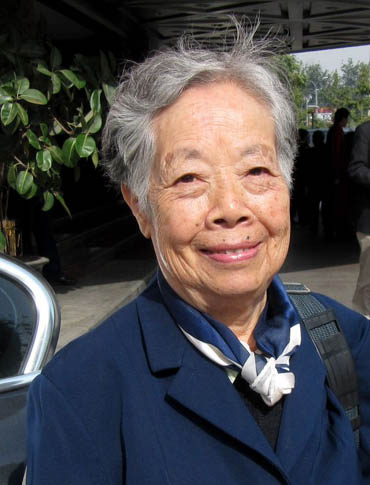| Location: Home > News > Events |
| Chang-Kang HU Passed Away at Age 83 |
|
Ms Chang-Kang Hu died peacefully, on 25 July 2011 in Beijing, China, from a respiratory failure after a short struggle of cancer. Her health worsened following the death of her husband, Tung-Sheng Liu, in 2008. They married in 1955. Ms Chang-Kang Hu was born on December 30, 1928, in Shaoxing, a historical town in Zhejiang Province, South China, which is well known for its culture heritage and pastoral scenery. Ms Hu attended the Sino-French University(The sister University with Institut Franco-Chinois de Lyon founded in 1921)and majored in Biology from 1947 to 1950 in Beijing, and then transferred to Nankai University in Tianjin, where she received her BS degree in Biology in 1951. After graduation, she was assigned by the Central Government to the Cenozoic Research Laboratory, under the Committee of Chinese Geological Planning (later Ministry of Geology), as a research assistant to C. C. Young, a giant in paleontology as well as one of the pioneers of Chinese modern science. In 1953, when the new Laboratory of Vertebrate Paleontology (the precursor of the Institute of Vertebrate Paleontology and Paleoanthropology, IVPP) was established in the Academia Sinica, Beijing, Ms Hu followed C.C. Young to the new institute and took a position therein. Soon she engaged in the study of vertebrate paleontology and published her early papers on mammal fossils from Choukoutien and other localities in 1953. During the following years, she had worked with a German scholar, Dr. H. D. Kahlke, on the distribution of the giant deer in China, and had enjoyed the friendship with two generations of the Kahlkes family over sixty years. In 1950s and 1960s, Ms Chang-Kang Hu joined many important field expeditions organized by IVPP, among which the most famously one was the Sino-Soviet Paleontological expedition. In that expedition, Ms Hu was the deputy leader as well as one of the leading scientists of the team. She had since kept the contact with one of her Russian teammates, Mikhail A. Shishkin, from the expedition. For many years, numerous scientific researches have been accomplished by Ms Hu and her collaborators through their hard work, despite limited resources and poor working conditions in those early days of China. Important publications by Ms Hu and her colleagues include “Mammalian Fossils Associated with the Hominid Skull Cap of Lantian, Shaanxi”(with Min-Chen Chou & Y. C. Lee in 1965) and the Monograph with Tao Qi on Gongwangling Pleistocene Mammalian Fauna of Lantian, Shaanxi in 1978. Similar to many other scientists in her generation, Ms Hu’s life was not an easy one. She had to finish up her high school under the threat of air raid during the day in the war against Japanese. She had to be transferred to another university in the year of her graduation because her university was closed after the Chinese civil war. She had to do everything but science during the Culture Revolution for ten years. Until late 1970s, when China fortunately resumed a normal condition, Ms Chang-Kang Hu could eventually continue her work on fossil mammals and was promoted to an associate research professor at IVPP, Academia Sinica in 1978. In 1980s she had led a small team from IVPP and visited Smithsonian Institution, University of Pittsburgh, and University of Kansas, and joined some field excavations in Denver and Colorado in a short scientific exchange program in United States. She was also one of exchanging scholars to the United Kingdom. The most outstanding work of Chang-Kang Hu was her involvement, as the senior scientist, in the successful introduction of the endangered Père David’s Deer (Elaphurus davidianus) from Woburn Abby,UK, to China in 1985-87. As a joint-project with Marquess of Tavistock and Oxford University, a total of 18 individuals were successfully released to the Nanhaizi Milu Conservation Park, Beijing. In 2011 the population has expanded to over 1000 individuals. In late 1980s, the Chinese Academy of Sciences was under a large scale restructuring and a sizable number of senior scientists had to face early retirement. Among them was Ms Chang-Kang Hu, then in the position of associate research professor in 1989. Without complaining personal loss resulted from the Institutional downsize in the next two decades, Ms Hu instead chose to take an easy, humble and modest way of life, in which she redefined her role as the most appreciated assistant to her husband, Professor Tung-Sheng Liu, in pursuing his excellent research of Chinese loess. Her love to him and dedication to his work helped to shine those important innovative findings by Tung-Sheng Liu that tell us the earth’s changing environments and climates now well known to the Quaternary community. Professor Tung-Sheng Liu once said whole heartedly that he was fortunate to have his wife Chang-Kang Hu and the Chinese loess, the two most valuable treasures in the second half of his life. Ms Chang-Kang Hu was a paleontologist, mother and wife, but more she was such an elegant and caring person, always being generous and kind to her friends, old or young - a person who will always be missed by her friends. Ms Chang-Kang Hu passed away at age 83; She is survived by a son and a daughter, three grandsons and a great granddaughter. |
